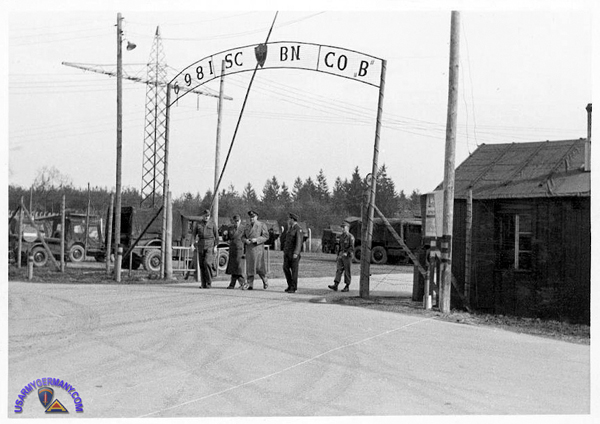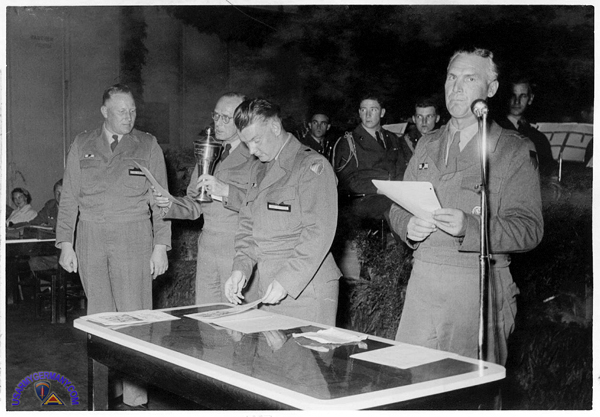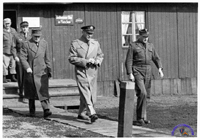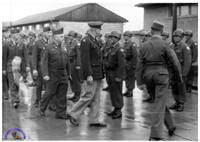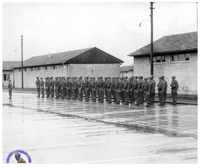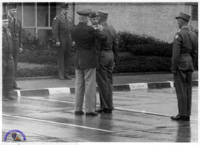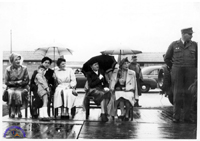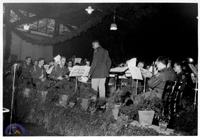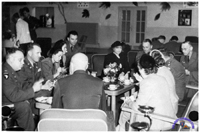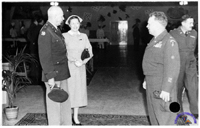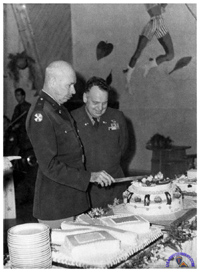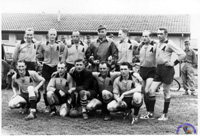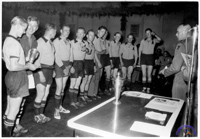| If you do
NOT see the Table of Contents frame to the left of this page, then
Click here to open 'USArmyGermany' frameset |
||||||||||||||||||||||||
|
Labor Service Signal Construction |
||||||||||||||||||||||||
|
|
||||||||||||||||||||||||
|
||||||||||||||||||||||||
|
|
||||||||||||||||||||||||
| 6980th LS Signal Construction Battalion | ||||||||||||||||||||||||
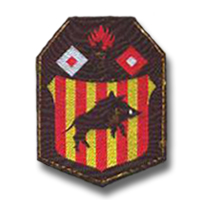 6980th LS Sig Cons Bn Patch (courtesy Siegbert Mann) 6980th LS Sig Cons Bn Patch (courtesy Siegbert Mann) |
||||||||||||||||||||||||
| 6981st CSC History | ||||||||||||||||||||||||
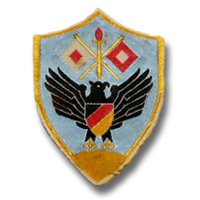 6981st LS Battalion (Sig Cons) Patch
6981st LS Battalion (Sig Cons) Patch |
||||||||||||||||||||||||
(Source: 5th Signal Command website - accessed 11-06-2013) |
||||||||||||||||||||||||
HISTORY The 6981st CSG is a direct descendant of the first German Labor Service (LS) Units activated in August 1948 during the Berlin blockade. The history of the 6981st CSG begins on May 1, 1952 with activation of the 6981st LS Signal Construction Battalion at Neureut near Karlsruhe. The unit consisted of 712 men organized into a headquarters company and three signal construction companies. Since its inception the unit has undergone major changes, most of which centered on complying with the existing Tariff Agreement and German Labor Law. In 1982, all LS Companies and CLG's were designated into Civilian Support Groups/Civilian Support Centers (CSG/CSC). Despite the many changes for years the 6981st continued its original mission including installation of high frequency antennas and maintenance and operation of microwave radio equipment and power generators. As a result of downsizing of US Forces in Europe, the 6981st CSC was reorganized into the 6981st CSG with three Regional Signal Support Detachments on 1 July 1993. In July 1995, the 6981st was restationed to Mannheim-Sandhofen and headquartered at Coleman Barracks. The 6981st was again reorganized and their regional Signal Support Detachments were deactivated in September 1995. The unit headquarter 's is still at Coleman Barracks, Mannheim-Sandhofen with one Signal Support Detachment stationed in Grafenwoehr. Since 1952, the parent organization of the 6981st has varied and included
|
||||||||||||||||||||||||
| If you have more
information on the history or organization of the 6981st CSC, please
contact me |
||||||||||||||||||||||||
| (Source: Photos submitted by Matthias Menge, USAREUR) | ||||||||||||||||||||||||
| (Source: Email from Hans Chevalier ) | ||||||||||||||||||||||||
| I served with Company C, 6981st Labor Service Signal Construction Battalion in Neureut near Karlsruhe from 1952 till 1962. Since1964 my family and I reside in New York. I am also a member of the 17th Signal Battalion Assoc. as the only member of the 6981. It would be great to hear from some old LS buddies in this country I joined the 6981 Sign Con Bn in Febr. 1952 at Neureut. Ltc. Walter G. Franz (former General of the Luftwaffe) commanded a total strength of 712 men, consisting of headquarters company and three signal construction companies. After the Bundeswehr was formed in the Federal Republic of Germany in 1955, the German LS units were redesignated as Civilian Labor Groups (CLG). The units underwent a major change and a more civil character was emphasized, subject to a Tariff Agreement and the German Labor Law. In July 1972, the 4038th LS Signal Construction Company was assigned to the 6981st. Effective 16 Jan 1982, all LS Companies and CLG were designated into Civllian SupportGroups / Civilian Support Centers (CSG/CSC). For many years the 6981st continued its mission including cable construction and maintenance, HF and ATC antenna installation and maintenance and operation of microwave radio equipment and power generators at DCS microwave radio sites in Germany. As a result of the downsizing of US Forces in Europe, the 6981st CSG (Sig Const&Spt) was reorganized into the 6981st CSG with three Regional Signal Support Detachmnets on 1 July 1993. Subordinate CSG's were inactivated and the 6981st strength was reduced from 528 to 163 authorizations. In July 1995, the 6981st was restationed to Mannheim-Sandhofen and headquartered at Coleman Barracks. The 6981st was again reorganized in October 1995. In 2002, the unit was still headquartered at Coleman Barracks, with one Signal Support Detachment stationed in Grafenwoehr. The unit's strength in 2002 was 91 personnel, and the Commander was Major Heinrich Nonnenmacher. Since the inception of the 6981st, the unit was assigned to various commands, including: This unit history I obtained from an invitation to the 50th Anniversary 2002. I do note know if the unit still exists as of the present time. Also, I do not know who the present Commander is. I hope this info will help you. Hans Chevalier |
||||||||||||||||||||||||
| (Source: Email from Klaus Thamm, 6981st CSC, 1950s-60s) | ||||||||||||||||||||||||
| I joined the 6981st CSC in May 1952 and stayed with the unit until 1966. During this period I performed various jobs: In April 2006 we will have a reunion for all former members. I will try to collect more material then. |
||||||||||||||||||||||||
| Click here to see 6981st photos submitted by Klaus Thamm | ||||||||||||||||||||||||
| (Source: Email from Philip W.P. Kermott) | ||||||||||||||||||||||||
| I was one of the US Officers who formed and trained these batallions. The 6980th LS Battalion was originally commanded by LS Lt. Col Joppich. The 6981st LS Battalion was commanded by LS Lt Col. Franz. I first met Gen Franz shortly after he was signed on as an LS 1st Lt. of the 8200 Sig (Signal Construction) Company, a unit of the newly formed 6981. The command was really not sure that they didn’t have someone who was ‘over qualified’. He was sent to Frankfurt to erect a rhombic antenna. I was sent along with several Non Coms to rate him. My instructions to the NCO’s were to not ‘take over’ but to let him do it himself. I was able to report that ‘Lt Franz’ was capable of remembering what a good junior officer could do. I Later served as the US Officer assigned to the Bn. I (together with my young pregnant wife and 1st child) arrived in Germany in the latter part of April 1950. The Army waited until after May Day (for political reasons) before assigning me to Hanau Signal Depot for the 51st LSC (Labor Supervision Company) and it’s Signal Depot Company. A month or so later a US officer and several US NCOs arrived in the area do Signal Construction Work for an Army Security Agency station near the depot. The actual work was done by members of the 8002nd LS Company (Signal Construction). After another month or so, I assumed command of the 51st and sent to Grafenwoehr, with orders to form the 6980th. Since I was no yet promoted to 1st Lt., (that happened on Aug 5th, 1950) I was absorbed into the 7776th Supervision Center, shortly to be commanded by Col. Sydney S Davis. The 6980th cadre was largely LS Officers and NCO’s of the 8002nd (the 8002nd LS Capt Joppich became it’s commander) together with some LS Supply people that I had recruited from the Signal Depot. As soon as we were formed and largely staffed, the units were transferred to Ansbach where the 589th Signal Construction Company, US Army) and 8002nd were stationed. The 6980th was equipped and trained in Ansbach, but was really too large a unit for the Area. By the way, training included being armed and trained with the US M1 carbine. A Kaserne (Neureut Cantonment) was built near Karlsruhe to house the 6980th and the as yet unformed 6981st. The 6980th became operational and was engaged in various activities in support of US field exercises (primarily Spiral 4 field cable installations), and tactical fixed wire installations. By the time the US V Corps (7th Army) replaced the US Constabulary force, the 6981st was becoming operational. They were assigned to do mostly fixed station signal construction at newly formed Kasernes, or expansions to existing Kasernes. At that time a US officer was assigned to any LS Unit that was detached for such duty. It was thus that I first met General Franz (as I understood it, he had been the Luftwaffe’s Chief Signal Officer). It was shortly after this time that he was promoted to LS Lt Col as the 6981st Battalion commander. About this time I was appointed the one US Officer to serve with the 6981st. Most of our LS Officers had been either German Officers or Senior Non–commissioned Officers during WWII. I remember a Horst Burrow who commanded the 8200th LS Company, had been a Navy CPO (submarines no less) but also had a lot of experience as a cable splicer with the Deutsche Post. As an enlisted man during WWII, I had been a paratrooper. I gained a lot of respect for those LS people that I worked with, and could understand the war stories that they told me. In that situation we shared social functions as well. My first wife, who passed away in 2002, remembered the old world kiss on the hand that she received from General Franz until her dying day. In 1952, LS Units adopted a ‘Good Conduct Medal’. They decided to award some to some of the US personnel that had been working with them for awhile. I still have mine somewhere around the house. It was numbered 3094. After my tour with the German Labor Service Signal Construction Battalions, I returned to the US to continue my military career. After a wide variety of interesting assignments I retired from the Army in 1968. My time with the German LS Signal Construction units is still one of my fondest memories. I happened to remember that initially, both battalions had a headquarters company and 3 Signal Construction Companies. They were equipped under the then current US Army T/O&E 11-27N. Their administration mirrored that of the US Army. The rank system was also that of the US Army. Initially, the US personnel were to assure compliance with Signal Corps Standards (approximating Bell systems, rather than other standards). By early 1953, fewer officers were assigned this sort of supervision although there were always some NCOs in an advisory capacity. My last assignment with the 6981st was to provide liaison with the US bases where various units and detachments were providing services to installations. With the earlier services many labor service troops provided signal support for US units on field exercises, so more officers were needed. |
||||||||||||||||||||||||
|
|
||||||||||||||||||||||||
| Newspaper Articles | ||||||||||||||||||||||||
| Civilian Labor Group, By CPT Patrick L. Faver, Fall 1977 | ||||||||||||||||||||||||
|
||||||||||||||||||||||||
|
|
||||||||||||||||||||||||
| Related
Links: Labor Service / Civilian Support - the only unofficial homepage of the Labor Service, the Civilian Support Organization of USAREUR, the Industrial Police (IP) and the USAFE Civilian Service Units worldwide. |
||||||||||||||||||||||||

